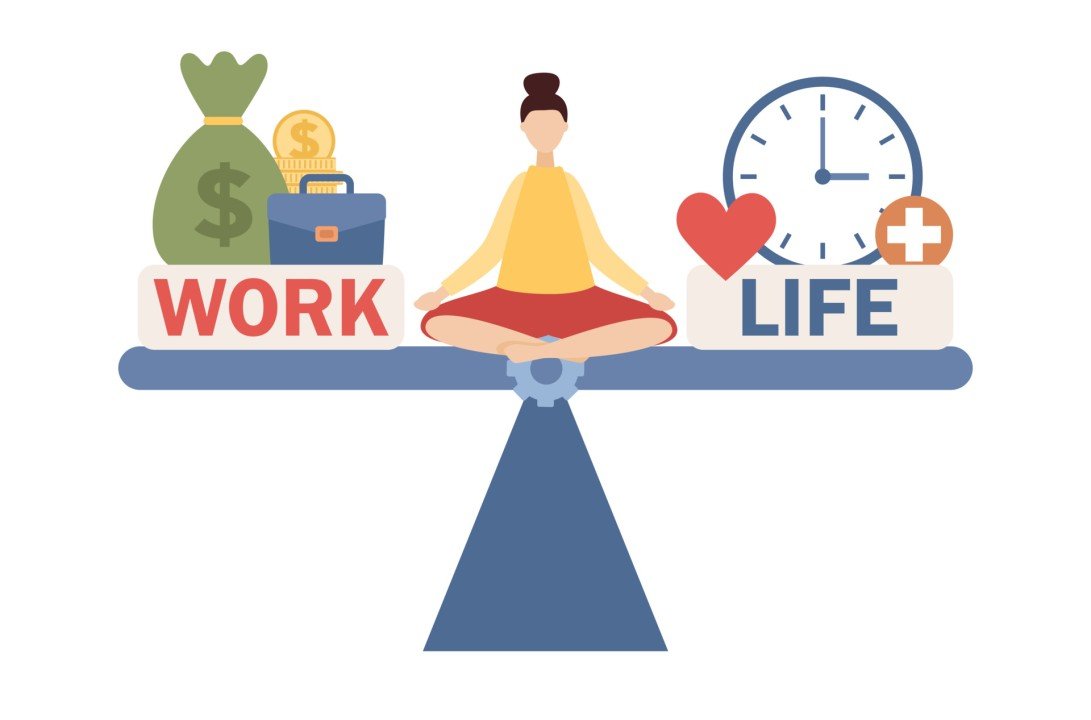
ABSTRACT
In the modern workforce, for a women and work-life balance
remains a significant challenge. This paper explores the factors contributing to this
imbalance, the consequences for women’s well-being and career progression, and
potential solutions for creating a more equitable work environment. The analysis
considers the global context, highlighting cultural variations and the evolving
nature of work.
INTRODUCTION
The image of a woman balancing work, family, and personal well-being is a ubiquitous one. Yet,
for many women in the modern workforce, achieving this balance feels more like a constant
juggling act, with balls threatening to drop at any moment. Despite significant strides in female
participation in the global workforce, the pressure to reconcile professional demands with
domestic responsibilities remains a significant challenge disproportionately impacting women.
This persistent struggle has far-reaching consequences, impacting not only women’s physical and
mental health but also their career trajectories and family dynamics. Women have made
significant strides in the workforce globally. However, the pressure to balance work demands
with family and personal responsibilities disproportionately burdens women. This paper
examines the complexities of achieving work-life balance for women, analyzing the causes,
consequences, and potential solutions.
Moving beyond the challenges, this paper will also explore potential solutions. We will examine how progressive workplace policies, such as flexible work arrangements and comprehensive parental leave, can help alleviate some of the pressure on working mothers. We will also consider the role of shifting cultural norms in
promoting a more equitable division of domestic labor and challenging traditional gender
stereotypes. Additionally, we will explore how technological advancements can empower
women to manage their time more effectively.
Finally, the role of government policies in supporting working families through affordable childcare, healthcare access, and family-friendly legislation will be addressed. By examining the challenges and potential solutions, this paper
aims to contribute to a more comprehensive understanding of work-life balance for women.
Our goal is to encourage a dialogue that promotes creating a work environment that is more
supportive and recognizes the unique demands women face. Ultimately, achieving a genuine
balance between work and personal life for women requires a collective effort from employers,
policymakers, and society as a whole.
Factors Affecting Work-Life Balance
The struggle to achieve work-life balance for women is a complex issue influenced by a
confluence of social, cultural, and economic factors. Here’s a deeper dive into some of the key
contributors to this persistent challenge:
● Unequal Division of Domestic Labor : Traditional gender roles often assign primary
responsibility for childcare and housework to women, even when they are employed
full-time. This creates a “double shift” for women, extending their workday beyond paid
employment. Studies show that even when both partners are employed, women typically
dedicate significantly more time to unpaid domestic labor, leaving them with less time for
rest, relaxation, and personal pursuits.
● Lack of Workplace Flexibility : Rigid work schedules, limited access to parental leave
policies, and inadequate child care options make it difficult for women to manage work
demands alongside family responsibilities. These inflexible work structures often fail to
accommodate school holidays, childcare needs, or unexpected illnesses within the family,
forcing women to make difficult choices between their work and their family’s
well-being.
● Long Working Hours : Globalization and competitive pressures often lead to extended
working hours, leaving women with less time for personal life and self-care. This
pressure to be constantly connected and responsive to work demands can significantly
encroach on women’s personal time, leaving them feeling exhausted and unable to fully
disconnect and recharge.
● Cultural Expectations : Societal norms may judge women more harshly for neglecting
their family duties compared to men, leading to feelings of guilt and pressure. This can
create immense pressure on working mothers to prioritize domestic responsibilities, even
if it means sacrificing career advancement opportunities or personal well-being.
● Lack of Affordable Childcare : The high cost of childcare, particularly high-quality
childcare, presents a significant hurdle for working mothers. Limited access to affordable
childcare options can force women out of the workforce entirely or restrict their working
hours, impacting their financial independence and career opportunities.
● Limited Support Systems : The absence of strong support systems, such as extended
family networks or reliable and affordable childcare options, can exacerbate the
challenges faced by working mothers. This lack of support can leave women feeling
isolated and overwhelmed, making it difficult to manage the demands of work and family
life effectively.
These factors often intertwine, creating a web of challenges for working women. Understanding
these complexities is crucial for developing workplace policies, social attitudes, and government
initiatives that can contribute to a more equitable and sustainable work-life balance for all.
Consequences of Work-Life Imbalance
The constant struggle to achieve work-life balance for women comes at a significant cost,
impacting their physical and mental well-being, career progression, and family dynamics. Let’s
explore some of the key consequences of this imbalance:
Physical and Mental Health Issues:
● Stress and Burnout: The constant juggle between work and personal life can lead to
chronic stress, exhaustion, and burnout. Women often experience symptoms like anxiety,
difficulty sleeping, and physical complaints due to the constant strain on their physical
and mental resources.
● Increased Risk of Health Problems: Work-life imbalance can contribute to a decline in
overall health for women. Chronic stress can weaken the immune system, increasing
susceptibility to infections and chronic conditions. Additionally, women may neglect
their own health needs due to lack of time and energy, leading to delayed preventive care
and worsening existing health conditions.
Impact on Career Progression:
● Limited Career Advancement: The demands of managing work and family life can
hinder women’s ability to take on additional responsibilities or pursue opportunities that
require extra time or travel. This can put women at a disadvantage compared to their male
counterparts who may be able to dedicate more uninterrupted time to their careers.
● The “Mommy Track” Phenomenon: Some women facing work-life challenges may be
pushed towards less demanding or part-time positions to accommodate their family
responsibilities. While this may offer greater flexibility in the short term, it can limit
women’s earning potential and long-term career trajectory.
Impact on Families:
● Strained Family Relationships: When women struggle to balance work and family life,
it can create tension and conflict within the family. Mothers may experience guilt about
lack of quality time with their children, while partners may feel the burden of increased
domestic responsibilities. This stress can negatively impact communication and overall
family functioning.
● Impact on Children: Children of working mothers who are constantly stressed and
overwhelmed may experience emotional and behavioral problems. The lack of quality
time and attention can impact a child’s development and well-being.
Reduced Job Satisfaction and Productivity:
Women experiencing work-life imbalance may report lower levels of job satisfaction and
engagement. The constant stress and lack of personal time can lead to decreased motivation,
reduced productivity, and higher absenteeism rates.
Global Considerations
The struggle for work-life balance for women is a global phenomenon, but the specific
challenges and available solutions can vary significantly depending on the context. Here’s a
closer look at some key considerations across different regions:
Developed vs. Developing Countries:
● Access to Resources: Developed countries often have better access to childcare options,
parental leave policies, and social safety nets, which can alleviate some of the burden on
working mothers. In developing countries, these resources may be scarce or absent
entirely, placing a heavier burden on women and families.
● Economic Precarities: In many developing countries, women may be forced to work long
hours in informal sectors to make ends meet, leaving little time for family or personal
life. Economic factors can significantly limit their choices and flexibility.
Cultural Variations:
● The Concept of “Work-Life Balance”: The very concept of “work-life balance” can be
culturally specific. In some collectivist cultures, extended family networks may provide
more support for childcare and domestic responsibilities, easing the pressure on working
mothers. However, these cultures may also have more rigid gender roles that limit
women’s career aspirations.
● Gender Norms: Traditional gender roles regarding work and family life vary greatly
across cultures. In some regions, women may face greater societal pressure to prioritize
family duties over their careers.
The Need for a Multifaceted Approach:
Understanding these global variations is crucial for developing effective solutions. A
“one-size-fits-all” approach won’t work. Policies and initiatives need to be tailored to address the
specific needs and cultural contexts of different regions.
Additionally, international collaboration and knowledge sharing
can play a significant role.
Countries with successful policies and programs supporting working mothers can serve as
models for others.
By acknowledging these global considerations, we can work towards creating a more equitable
and supportive work environment for women everywhere, regardless of their cultural
background or geographical location.

Potential Solutions: Fostering a More Balanced Future for
Working Women
Achieving a genuine work-life balance for women requires a multi-pronged approach involving
collaborative efforts from employers, policymakers, and society as a whole. Here’s an
exploration of some potential solutions:
Workplace Policies:
Flexible Work Arrangements : Promoting options like flexible work schedules, compressed
workweeks, job-sharing arrangements, and remote work opportunities can significantly reduce
work-life stress for women. This allows them to manage childcare responsibilities, appointments,
and personal needs with greater ease.
● On-Site Childcare Facilities: Providing on-site childcare facilities or partnerships with
nearby childcare providers can be a game-changer for working parents. This eliminates
the commute and stress of finding reliable childcare, allowing women to focus on their
work while knowing their children are well-cared for close by.
● Generous Parental Leave Policies: Offering extended parental leave (both maternity and
paternity) provides valuable time for mothers and fathers to bond with their newborns
and adjust to parenthood. This policy should be paid and encourage fathers to take an
active role in childcare, promoting a more equal division of responsibilities.
Shifting Cultural Norms :
● Challenging Gender Stereotypes: Public awareness campaigns and educational initiatives
can help challenge traditional gender roles regarding domestic labor. Encouraging men to
share household chores and childcare responsibilities normalizes a more equitable
division of labor, alleviating the burden on women.
● Supporting Working Fathers: Promoting policies and cultural shifts that encourage fathers
to take on a more active role in childcare and domestic duties can significantly contribute
to a more balanced work-life dynamic for families. This requires dismantling societal
pressures that view childcare as primarily a woman’s responsibility.
● Workplace Culture Shift: Companies can cultivate a culture that values work-life balance
and discourages working long hours or responding to emails outside of work hours. This
encourages employees to disconnect and prioritize personal time, leading to increased
well-being and potentially even higher productivity.
Technological Advancements :
● Leveraging Technology: Technology can be a powerful tool for women seeking to
manage work and family life more effectively. Utilizing online collaboration tools,
project management software, and communication platforms can streamline workflow
and reduce the need for extended physical presence in the office.
● Flexible Scheduling Apps: Apps that allow for flexible scheduling and time management
can empower women to control their work hours and plan their days more efficiently,
accommodating childcare needs, appointments, and other personal commitments.
Government Support :
● Investment in Affordable Childcare: Government investment in affordable, high-quality
childcare facilities across the nation can significantly reduce the financial burden on
working families. This ensures access to safe and nurturing environments for children,
allowing parents, particularly mothers, to participate fully in the workforce.
● Healthcare Access and Family-Friendly Policies: Policies promoting access to affordable
healthcare, including mental health services, can support the well-being of working
mothers. Additionally, policies like subsidized meal programs or tax breaks for childcare
expenses can alleviate financial pressure on families.
Conclusion
Creating a more balanced work-life experience for women requires a holistic approach. By
implementing progressive workplace policies, fostering a cultural shift towards gender equality,
and leveraging technology and government support, we can build a future where women can
thrive in both their professional and personal lives. Ultimately, achieving this balance benefits
not just women but also families, businesses, and society as a whole.Achieving genuine work-life
balance for women requires a multi-pronged approach.
Employers, policymakers, and society as a whole must work together to create a more supportive environment that recognizes and addresses the unique challenges women face. By promoting workplace flexibility, fostering equal sharing of domestic responsibilities, and challenging societal norms, we can move towards a more equitable and sustainable work-life balance for all. Achieving genuine work-life balance for women requires a multi-pronged
approach. Employers, policymakers, and society as a whole must work together to create a more
supportive environment that recognizes and addresses the unique challenges women face. By promoting
workplace flexibility, fostering equal sharing of domestic responsibilities, and challenging societal norms,
we can move towards a more equitable and sustainable work-life balance for all.




